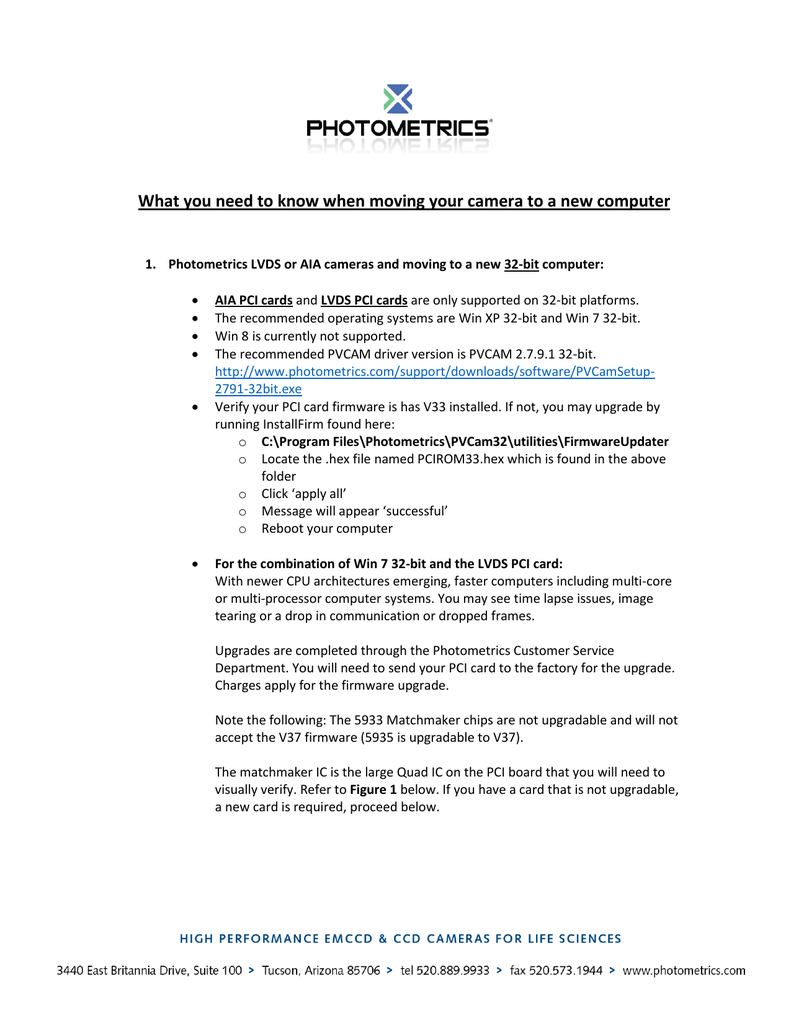-->
- Photometrics 1394 Driver Software
- Photometrics 1394 Driver
- Photometrics 1394 Driver Manual
- Photometrics 1394 Driver Test
Windows 7 includes 1394ohci.sys, a new IEEE 1394 bus driver that supports faster speeds and alternative media as defined in the IEEE-1394b specification. The 1394ohci.sys bus driver is a single (monolithic) device driver, implemented by using the kernel-mode driver framework (KMDF). The legacy 1394 bus driver (available in earlier versions of Windows) includes multiple device drivers that were implemented by using the Windows Driver Model (WDM) in a port/miniport configuration. The 1394ohci.sys bus driver replaces the legacy port driver, 1394bus.sys, and the primary miniport driver, ochi1394.sys.
The new 1394ohci.sys bus driver is fully backward compatible with the legacy bus driver. This topic describes some of the known differences in behavior between the new and the legacy 1394 bus driver.
AreaDetector: EPICS software for area detectors. Module Owner: Mark Rivers: University of Chicago. This page is the home of areaDetector, an application for controlling area (2-D) detectors, including CCDs, pixel array detectors, and online imaging plates. Visual Photometric Tool 1.2.46 copyright 2020, Acuity Brands Lighting. This Photometric report has been generated using methods recommended by the IESNA. Calculations are based on Photometric data provided by the manufacturer, and the accuracy of this Photometric report is dependent on the accuracy of the data provided. Windows installed 'Texas Instrument 1394 OHCI Compliant Controller', driver version 10.0.15063.0 with a date of 6/21/2006 which sounds like it installed the 'Legacy' driver. However, I can't find any reference to this driver and whether it is the 'Legacy' driver or not. Cooper Lighting Solutions Photometric Lab 1121 Highway 74 South. ELECTRONIC DRIVER Summary Lumens per Lamp: N/A. 75° 426.6 486.6 794.6 1024.0 1394.6 2663.5.
Note
The 1394ohci.sys driver is a system driver that is included in Windows. It is automatically loaded when you install a 1394 controller. This is not a redistributable driver that you can download separately.
I/O Request Completion
All I/O requests that are sent to the new 1394 bus driver return STATUS_PENDING because the 1394ohci.sys bus driver is implemented by using KMDF instead of WDM. This behavior differs from that of the legacy 1394 bus driver, in which certain I/O requests complete immediately.
A client driver must wait until I/O requests sent to the new 1394 bus driver are complete. You can provide an I/O completion routine that is called after the request is complete. The status of the completed I/O request is in the IRP.
Configuration ROM Retrieval
The new 1394 bus driver tries to use asynchronous block transactions at faster bus speeds to retrieve the contents of a node's configuration ROM. The legacy 1394 bus driver uses asynchronous quadlet reads at S100 speed—or 100 megabits per second (Mbps). The 1394ohci.sys bus driver also uses the values that are specified in generation and max_rom entries of the node's configuration ROM header to improve the retrieval of the remaining content of the configuration ROM. For more information about how the new 1394 bus driver retrieves the contents of a node's configuration ROM, see Retrieving the Contents of a IEEE 1394 Node's Configuration ROM.
IEEE-1394-1995 PHY Support
The 1394ohci.sys bus driver requires a physical layer (PHY) that supports IEEE-1394a or IEEE-1394b. It does not support a PHY that supports IEEE-1394-1995. This requirement is due to the 1394ohci.sys bus driver's exclusive use of short (arbitrated) bus resets.
NODE_DEVICE_EXTENSION Structure Usage
A client driver can reference the device extension in the 1394 bus driver associated with the physical device object (PDO) for the device that the client driver controls. This device extension is described by the NODE_DEVICE_EXTENSION structure. In 1394ohci.sys, this structure remains at the same location as in the legacy 1394 bus driver, but the nonstatic members of the structure might not be valid. When a client driver uses the new 1394 bus driver, they must make sure that the data accessed in NODE_DEVICE_EXTENSION is valid. The static members of NODE_DEVICE_EXTENSION that contain valid data are Tag, DeviceObject, and PortDeviceObject. All other members NODE_DEVICE_EXTENSION are nonstatic, which the client driver must not reference.
Gap Count Optimization
The default behavior of the 1394ohci.sys bus driver is to optimize the gap count when it finds only IEEE 1394a devices on the 1394 bus, excluding the local node. For example, if the system that is running 1394ohci.sys has a host controller that complies with IEEE 1394b but all devices on the bus comply with IEEE 1394a, then the new 1394 bus driver tries to optimize the gap count.

Gap count optimization occurs only if the 1394ohci.sys bus driver determines that the local node is the bus manager.
Photometrics 1394 Driver Software

The 1394ohci.sys bus driver determines whether a device complies with IEEE-1394a by the speed setting in the node's self-id packet. If a node sets both of the bits in the speed (sp) field in the self-id packet, then 1394ohci.sys considers the node to comply with IEEE-1394b. If the speed field contains any other value, then 1394ohci.sys considers the node to comply with IEEE-1394a. The gap count value that is used is based on table E-1 in the IEEE-1394a specification, which provides the gap count as a function of hops. The 1394ohci.sys bus driver does not compute the gap count. You can change the default gap count behavior by using a registry value. For more information, see Modifying the Default Behavior of the IEEE 1394 Bus Driver.
Device Driver Interface (DDI) Changes
In Windows 7, the 1394 DDIs were changed to support faster speeds as defined by the 1394b specification and improved to simplify the development of 1394 client drivers. For more information about the general DDI changes that the new 1394 bus driver supports, see Device Driver Interface (DDI) Changes in Windows 7.
Related topics
The IEEE 1394 Driver Stack
Retrieving the Contents of a IEEE 1394 Node's Configuration ROM
FEBRUARY 16, 2009--A new IEEE 1394 bus driver for FireWire cameras closes gaps in Microsoft's standard driver.
FEBRUARY 16, 2009--A new IEEE 1394 bus driver for FireWire cameras closes gaps in Microsoft's standard driver. The new driver eliminates the speed limits of the original Windows driver. As a result, AVT cameras with the IEEE 1394b interface, such as the Pike and Stingray, can transfer image data at the maximum data rate (S800), even when using Windows Vista and XP (SP2/SP3). The driver package conforms to the Microsoft Windows OHCI 1394 bus driver standard so other FireWire devices connected to the PC, such as hard drives, can continue to operate without difficulty. The AVT bus driver is intended for use with the AVT Active FirePackage Software Development Kit but also supports FireWire camera drivers included in imaging software from suppliers such as Cognex or Matrox. The package is compatible with the CMU (Carnegie Mellon University) 1394 camera driver.
Allied Vision Technologies
Stadtroda, Germany
www.alliedvisiontec.com
For related information, visit the Machine Vision Software topic center.
------
Photometrics 1394 Driver

PRESS RELEASE
Allied Vision Technologies GmbH
Niederlassung Ahrensburg
Klaus-Groth-Str. 1
22926 Ahrensburg
Germany
http://www.alliedvisiontec.com
President/CEO: Frank Grube
Registration Office: Jena HRB 208962
Headquarters:
Taschenweg 2a, 07646 Stadtroda / Germany
New FireWire Bus Driver Package from Allied Vision Technologies
The new AVT 1394 Bus Driver Package provides greater speed and more stability for Microsoft Windows-based imaging applications.
Photometrics 1394 Driver Manual
Allied Vision Technologies, leading manufacturer of digital cameras for industrial imaging, provides a new IEEE 1394 bus driver for its FireWire cameras, effective immediately. The driver closes gaps in Microsoft's standard driver and enables much more efficient image data transfer for Windows Vista and XP (SP2/SP3).
Open Road for Pixels: No Speed Limit for 1394b
Windows' standard FireWire driver is fundamentally suited for the IEEE 1394a standard. Newer functions, especially higher data speed, that were introduced with the IEEE 1394b standard, have not been fully supported. For this reason, devices with a 1394b interface cannot take advantage of full 800 MBit/sec data transfer rates, for example. Adding to this deficit are stability issues that are unacceptable for industrial and professional applications with high reliability demands.
Photometrics 1394 Driver Test
The new AVT 1394 bus driver eliminates the speed limits of the original Windows driver. As a result, AVT cameras with the IEEE 1394b interface, such as the Pike and Stingray, can transfer image data at the maximum data rate (S800), even when using Windows Vista and XP (SP2/SP3).
Full Compatibility for Easy Programming
The AVT 1394 driver package conforms to the Microsoft Windows OHCI 1394 bus driver standard. Thanks to this 100% compatibility, other FireWire devices connected to the PC -- such as hard drives -- can continue to operate with no difficulty, something generally not possible with proprietary bus drivers.
Ideally, the AVT bus driver is intended for use with the AVT Active FirePackage Software Development Kit, but it also supports FireWire camera drivers included in imaging software from suppliers such as Cognex or Matrox. Moreover, the AVT 1394 bus driver package is compatible with the CMU (Carnegie Mellon University) 1394 camera driver.
'With this new AVT 1394 bus driver package, system developers can take the best from the FireWire bus and achieve the maximum data rate possible for their AVT FireWire camera,' explained Jens Hashagen, Software Product Manager at Allied Vision Technologies. The driver can be used with 32-Bit Windows operating systems Vista, XP and 2000 and will be available free of charge as a download on the AVT website. According to Hashagen, a driver for the 64-bit versions of Windows XP and Vista is in development.